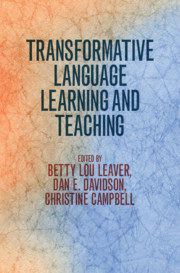Book contents
- Transformative Language Learning and Teaching
- Transformative Language Learning and Teaching
- Copyright page
- Contents
- Figures
- Tables
- Contributors
- Foreword
- Acknowledgments
- Abbreviations
- 1 Introduction
- Part I Theoretical Framework
- Part II Transformative Language Learning and Teaching Applications in Government Programs
- Part III Transformative Language Learning and Teaching Applications in University Programs
- 8 Authentic Resources and Written Reflection as Contributors to Transformative Learning
- 9 The Community as Transformative Classroom
- 10 Cultural Transformation
- 11 Designing Learning Environments to Facilitate Transformative Language and Culture Learning in a US Language Flagship Program
- Part IV Transformative Language Learning and Teaching Applications in Immersion Programs
- Part V The Learner
- Part VI Faculty Development
- Part VII Assessment
- References
- Index
11 - Designing Learning Environments to Facilitate Transformative Language and Culture Learning in a US Language Flagship Program
from Part III - Transformative Language Learning and Teaching Applications in University Programs
Published online by Cambridge University Press: 26 January 2021
- Transformative Language Learning and Teaching
- Transformative Language Learning and Teaching
- Copyright page
- Contents
- Figures
- Tables
- Contributors
- Foreword
- Acknowledgments
- Abbreviations
- 1 Introduction
- Part I Theoretical Framework
- Part II Transformative Language Learning and Teaching Applications in Government Programs
- Part III Transformative Language Learning and Teaching Applications in University Programs
- 8 Authentic Resources and Written Reflection as Contributors to Transformative Learning
- 9 The Community as Transformative Classroom
- 10 Cultural Transformation
- 11 Designing Learning Environments to Facilitate Transformative Language and Culture Learning in a US Language Flagship Program
- Part IV Transformative Language Learning and Teaching Applications in Immersion Programs
- Part V The Learner
- Part VI Faculty Development
- Part VII Assessment
- References
- Index
Summary
A transformative approach to language education calls for an expanded understanding of curriculum and program design that leverages potential learning environments both in and outside the classroom - in academic, residential, and social settings - to support language and culture learning. This chapter provides an overview of curricular and co-curricular learning environments designed by the University of Wisconsin-Madison Russian Flagship that offer affordances for transformative language and culture learning for its students. Elements of the program's design that facilitate transformative learning include: (1) positioning students as independent language learners striving to meet programmatic and personal goals; (2) providing a continuum of opportunities for language and culture learning in formal instructional environments, individual and small-group tutorials, and residential and social contexts in which students engage in meaningful interactions in Russian with various interlocutors, reflecting the concept of open architecture design for learning; and (3) offering spaces for reflection in supportive, low-stakes environments, potentially leading to transformative change.
Keywords
- Type
- Chapter
- Information
- Transformative Language Learning and Teaching , pp. 98 - 106Publisher: Cambridge University PressPrint publication year: 2021



